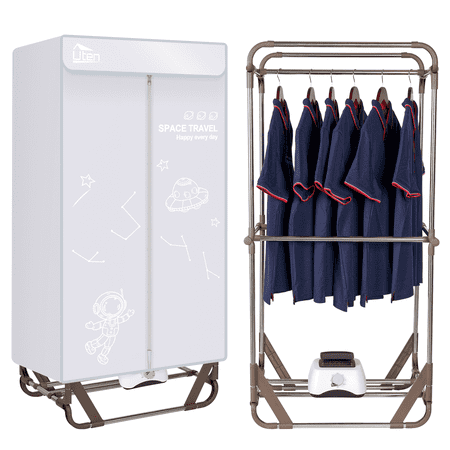This compact $70 heated airer revolutionized my winter laundry routine – and is perfect for my tiny home
I've said goodbye to musty laundry and mold

Chiana Dickson
When you don't have a tumble dryer, drying laundry in winter is a constant battle. Long drying times, musty smells, and the risk of mold make this already tedious task that bit more annoying.
Not wanting to spend hundreds of dollars on a tumble dryer, I needed to find an alternative solution to covering my radiators and vents.
That's where the Ulten Portable Dryer from Walmart came in to save the day. Now, my radiators aren't buried beneath sopping laundry when I'm drying clothes indoors in winter.
Why I love my portable clothes dryer

This portable clothes dryer comes with a 15000w motor to help dry clothes quickly no matter the temperature or the size of your home. The smaller one is $69.99 at Walmart.
The portable clothes dryer’s immediate pull was the compact size. It is nice and slim (no wider than a traditional clothes rack), so it easily slots into the corner of a small utility room or small living room. When not in use, it can be easily folded up and tucked away in under-bed storage ideas, too, so it doesn't cramp your living space.
I have tried various methods for drying clothes quickly without a tumble dryer, from hanging everything over heating vents, to spacing them out on an area in a well-ventilated spot, but nothing worked well enough to dry clothes in a small space – especially when I was already struggling to keep a poorly insulated house warm until I tried the compact heated airer.
How it works

The dryer works by pushing warm air up and over the clothes, which is then trapped in the drying bag to circulate. Given that most of the benefits of air-drying laundry outside come from a gentle breeze, this is the best way to emulate the summer sun in the dead of winter.
But what sets this apart from putting washing on a radiator? The constant air flow helps to speed the process up, reducing the likelihood of mold developing on your laundry, and helping laundry smell nice beyond laundry day.
Rinea Blanchard, founder and CEO of Superior Contract Cleaning explains, ‘Improperly ventilated and dried organic items (including clothes) invite mold growth. Mold grows when the following equation is met: organic matter and moisture. Having damp clothes put in the closet can allow moisture to accumulate, and since most closets are of wood (organic), this is the perfect breeding ground for mold.
‘This is especially true in more humid climates, like Florida or Louisiana, for example. Hence, a product like a heated airer could help dry out clothes to prevent moisture accumulation.’

There are some key heated airer mistakes to avoid, however, if you want to see results. Not covering the clothing as it dries will allow the heat to escape, slowing the process down again. You should also avoid overfilling the air or clothes bag. The more space you leave the more room there is for air to circulate and dry your clothes.
Perhaps the most important feature of this dryer was the low running cost, helping me save money on laundry. The average tumble dryer costs around 30-90 cents to run per hour. This handy dryer only costs approximately 18 cents per hour, not to mention it is a lot more affordable than many of the best tumble dryers, so you see the savings immediately. It also has a timer, so you can control exactly how long it runs.
It was not all plain sailing, however. There is no denying that drying clothes on an airer or a heating bag takes longer than a tumble dryer – and you often cannot dry as much in one go. You need to get good at sorting clothes for laundry and adjusting to smaller cycles when doing laundry to ensure you have enough room for everything to dry afterward.
What to shop

If you need more space to dry large laundry loads, this gull-wing dryer offers all the space you need. Try our heated airer trick to speed up drying and throw a dry bedsheet over the top to trap warm air

If you're on the other side of the spectrum and have even less available space to dry clothes indoors, try this clothes rail hanging dryer. It hooks onto an existing rail to save space in living areas

Drying clothes inside always comes with the risk of mold. To prevent mold growth on your clothes and around your home, use the best dehumidifier. It can even help speed drying times up, too
As with anything, there are pros and cons to drying clothes indoors, no matter what method you use, so it is worth weighing them up before deciding on a laundry approach that suits your household.
Sign up to the Homes & Gardens newsletter
Design expertise in your inbox – from inspiring decorating ideas and beautiful celebrity homes to practical gardening advice and shopping round-ups.
- Chiana DicksonContent Editor
-
 'Big results before you know it' – Experts urge you to use the ‘Take Away 10’ method for simple decluttering with zero decision fatigue
'Big results before you know it' – Experts urge you to use the ‘Take Away 10’ method for simple decluttering with zero decision fatigueIt can cut hundreds of items from your home in just a few weeks
By Ottilie Blackhall
-
 Kevin Bacon and Kyra Sedgwick's rustic kitchen island is stunning, but controversial – designers say you can get the look without the hassle
Kevin Bacon and Kyra Sedgwick's rustic kitchen island is stunning, but controversial – designers say you can get the look without the hassleA popular material finds an unorthodox home in the couple's kitchen, but experts disagree on whether it should be used – here's how to do it instead
By Sophie Edwards
-
 My cheap dehumidifier makes easy work of air drying laundry indoors despite the humidity of spring showers – get yours on sale for just $49 now
My cheap dehumidifier makes easy work of air drying laundry indoors despite the humidity of spring showers – get yours on sale for just $49 nowIt's useful for lots of things around my home
By Punteha van Terheyden
-
 Looking for a natural laundry-softening alternative? I'm a professional cleaner and it's time to ditch synthetic ones for 5 non-toxic softeners that work
Looking for a natural laundry-softening alternative? I'm a professional cleaner and it's time to ditch synthetic ones for 5 non-toxic softeners that workRefresh your laundry routine with these fabric softener alternatives
By Karina Toner
-
 Unlock the magical mold-killing and stain-busting superpower of this humble household ingredient that costs just 50 cents
Unlock the magical mold-killing and stain-busting superpower of this humble household ingredient that costs just 50 centsIf you have aspirin in the house, you can use it to banish mold
By Ottilie Blackhall
-
 5 warning signs you're using the wrong amount of detergent – avoid greasy residue, stiff fabrics and skin issues with these simple cleaner-approved tips
5 warning signs you're using the wrong amount of detergent – avoid greasy residue, stiff fabrics and skin issues with these simple cleaner-approved tipsPlus, why it's important to get the amount just right
By Ottilie Blackhall
-
 Laundry experts reveal 7 unexpected washing rules you can throw out the window – from separating fabrics to mixing whites and colors
Laundry experts reveal 7 unexpected washing rules you can throw out the window – from separating fabrics to mixing whites and colorsForget everything you thought you knew
By Ottilie Blackhall
-
 Using this button on your washing machine will cut your bills and help the planet
Using this button on your washing machine will cut your bills and help the planetA single switch can make a load of difference
By Chiana Dickson
-
 Experts reveal the 5 toxic items lurking in your laundry room – and what to swap them with for a healthier routine
Experts reveal the 5 toxic items lurking in your laundry room – and what to swap them with for a healthier routineFor a room focused on cleaning, some of its items can be surprisingly toxic
By Chiana Dickson
-
 7 laundry hacks experts swear by to make this endless chore simpler, cheaper and less taxing
7 laundry hacks experts swear by to make this endless chore simpler, cheaper and less taxingFrom laundry heroes worth the spend, to tweaking temperatures and beyond
By Chiana Dickson